Han Fang
Tracking-Aware Deformation Field Estimation for Non-rigid 3D Reconstruction in Robotic Surgeries
Mar 04, 2025Abstract:Minimally invasive procedures have been advanced rapidly by the robotic laparoscopic surgery. The latter greatly assists surgeons in sophisticated and precise operations with reduced invasiveness. Nevertheless, it is still safety critical to be aware of even the least tissue deformation during instrument-tissue interactions, especially in 3D space. To address this, recent works rely on NeRF to render 2D videos from different perspectives and eliminate occlusions. However, most of the methods fail to predict the accurate 3D shapes and associated deformation estimates robustly. Differently, we propose Tracking-Aware Deformation Field (TADF), a novel framework which reconstructs the 3D mesh along with the 3D tissue deformation simultaneously. It first tracks the key points of soft tissue by a foundation vision model, providing an accurate 2D deformation field. Then, the 2D deformation field is smoothly incorporated with a neural implicit reconstruction network to obtain tissue deformation in the 3D space. Finally, we experimentally demonstrate that the proposed method provides more accurate deformation estimation compared with other 3D neural reconstruction methods in two public datasets.
Think Smarter not Harder: Adaptive Reasoning with Inference Aware Optimization
Jan 31, 2025Abstract:Solving mathematics problems has been an intriguing capability of large language models, and many efforts have been made to improve reasoning by extending reasoning length, such as through self-correction and extensive long chain-of-thoughts. While promising in problem-solving, advanced long reasoning chain models exhibit an undesired single-modal behavior, where trivial questions require unnecessarily tedious long chains of thought. In this work, we propose a way to allow models to be aware of inference budgets by formulating it as utility maximization with respect to an inference budget constraint, hence naming our algorithm Inference Budget-Constrained Policy Optimization (IBPO). In a nutshell, models fine-tuned through IBPO learn to ``understand'' the difficulty of queries and allocate inference budgets to harder ones. With different inference budgets, our best models are able to have a $4.14$\% and $5.74$\% absolute improvement ($8.08$\% and $11.2$\% relative improvement) on MATH500 using $2.16$x and $4.32$x inference budgets respectively, relative to LLaMA3.1 8B Instruct. These improvements are approximately $2$x those of self-consistency under the same budgets.
ASAP: Learning Generalizable Online Bin Packing via Adaptive Selection After Pruning
Jan 29, 2025Abstract:Recently, deep reinforcement learning (DRL) has achieved promising results in solving online 3D Bin Packing Problems (3D-BPP). However, these DRL-based policies may perform poorly on new instances due to distribution shift. Besides generalization, we also consider adaptation, completely overlooked by previous work, which aims at rapidly finetuning these policies to a new test distribution. To tackle both generalization and adaptation issues, we propose Adaptive Selection After Pruning (ASAP), which decomposes a solver's decision-making into two policies, one for pruning and one for selection. The role of the pruning policy is to remove inherently bad actions, which allows the selection policy to choose among the remaining most valuable actions. To learn these policies, we propose a training scheme based on a meta-learning phase of both policies followed by a finetuning phase of the sole selection policy to rapidly adapt it to a test distribution. Our experiments demonstrate that ASAP exhibits excellent generalization and adaptation capabilities on in-distribution and out-of-distribution instances under both discrete and continuous setup.
Step-KTO: Optimizing Mathematical Reasoning through Stepwise Binary Feedback
Jan 18, 2025Abstract:Large language models (LLMs) have recently demonstrated remarkable success in mathematical reasoning. Despite progress in methods like chain-of-thought prompting and self-consistency sampling, these advances often focus on final correctness without ensuring that the underlying reasoning process is coherent and reliable. This paper introduces Step-KTO, a training framework that combines process-level and outcome-level binary feedback to guide LLMs toward more trustworthy reasoning trajectories. By providing binary evaluations for both the intermediate reasoning steps and the final answer, Step-KTO encourages the model to adhere to logical progressions rather than relying on superficial shortcuts. Our experiments on challenging mathematical benchmarks show that Step-KTO significantly improves both final answer accuracy and the quality of intermediate reasoning steps. For example, on the MATH-500 dataset, Step-KTO achieves a notable improvement in Pass@1 accuracy over strong baselines. These results highlight the promise of integrating stepwise process feedback into LLM training, paving the way toward more interpretable and dependable reasoning capabilities.
END$^2$: Robust Dual-Decoder Watermarking Framework Against Non-Differentiable Distortions
Dec 13, 2024Abstract:DNN-based watermarking methods have rapidly advanced, with the ``Encoder-Noise Layer-Decoder'' (END) framework being the most widely used. To ensure end-to-end training, the noise layer in the framework must be differentiable. However, real-world distortions are often non-differentiable, leading to challenges in end-to-end training. Existing solutions only treat the distortion perturbation as additive noise, which does not fully integrate the effect of distortion in training. To better incorporate non-differentiable distortions into training, we propose a novel dual-decoder architecture (END$^2$). Unlike conventional END architecture, our method employs two structurally identical decoders: the Teacher Decoder, processing pure watermarked images, and the Student Decoder, handling distortion-perturbed images. The gradient is backpropagated only through the Teacher Decoder branch to optimize the encoder thus bypassing the problem of non-differentiability. To ensure resistance to arbitrary distortions, we enforce alignment of the two decoders' feature representations by maximizing the cosine similarity between their intermediate vectors on a hypersphere. Extensive experiments demonstrate that our scheme outperforms state-of-the-art algorithms under various non-differentiable distortions. Moreover, even without the differentiability constraint, our method surpasses baselines with a differentiable noise layer. Our approach is effective and easily implementable across all END architectures, enhancing practicality and generalizability.
Improving Model Factuality with Fine-grained Critique-based Evaluator
Oct 24, 2024Abstract:Factuality evaluation aims to detect factual errors produced by language models (LMs) and hence guide the development of more factual models. Towards this goal, we train a factuality evaluator, FenCE, that provides LM generators with claim-level factuality feedback. We conduct data augmentation on a combination of public judgment datasets to train FenCE to (1) generate textual critiques along with scores and (2) make claim-level judgment based on diverse source documents obtained by various tools. We then present a framework that leverages FenCE to improve the factuality of LM generators by constructing training data. Specifically, we generate a set of candidate responses, leverage FenCE to revise and score each response without introducing lesser-known facts, and train the generator by preferring highly scored revised responses. Experiments show that our data augmentation methods improve the evaluator's accuracy by 2.9% on LLM-AggreFact. With FenCE, we improve Llama3-8B-chat's factuality rate by 14.45% on FActScore, outperforming state-of-the-art factuality finetuning methods by 6.96%.
Multi-IF: Benchmarking LLMs on Multi-Turn and Multilingual Instructions Following
Oct 21, 2024Abstract:Large Language Models (LLMs) have demonstrated impressive capabilities in various tasks, including instruction following, which is crucial for aligning model outputs with user expectations. However, evaluating LLMs' ability to follow instructions remains challenging due to the complexity and subjectivity of human language. Current benchmarks primarily focus on single-turn, monolingual instructions, which do not adequately reflect the complexities of real-world applications that require handling multi-turn and multilingual interactions. To address this gap, we introduce Multi-IF, a new benchmark designed to assess LLMs' proficiency in following multi-turn and multilingual instructions. Multi-IF, which utilizes a hybrid framework combining LLM and human annotators, expands upon the IFEval by incorporating multi-turn sequences and translating the English prompts into another 7 languages, resulting in a dataset of 4,501 multilingual conversations, where each has three turns. Our evaluation of 14 state-of-the-art LLMs on Multi-IF reveals that it presents a significantly more challenging task than existing benchmarks. All the models tested showed a higher rate of failure in executing instructions correctly with each additional turn. For example, o1-preview drops from 0.877 at the first turn to 0.707 at the third turn in terms of average accuracy over all languages. Moreover, languages with non-Latin scripts (Hindi, Russian, and Chinese) generally exhibit higher error rates, suggesting potential limitations in the models' multilingual capabilities. We release Multi-IF prompts and the evaluation code base to encourage further research in this critical area.
FAMSeC: A Few-shot-sample-based General AI-generated Image Detection Method
Oct 17, 2024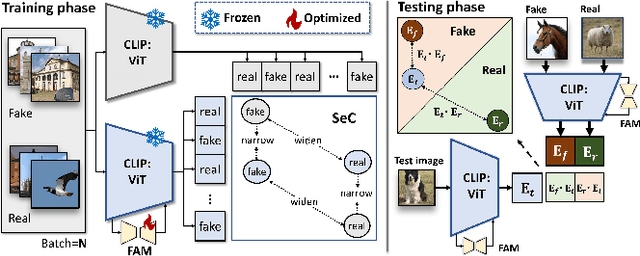
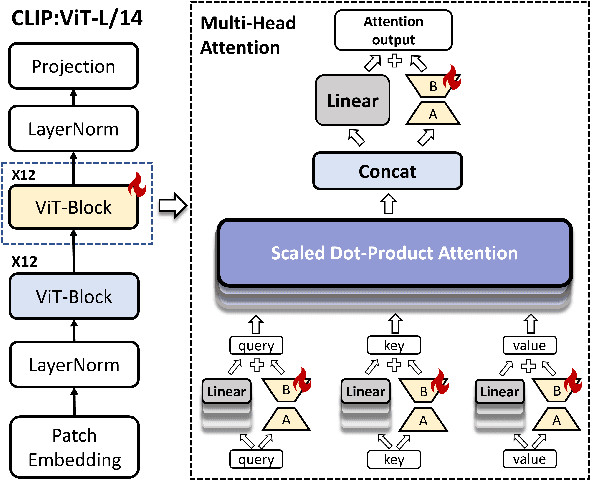
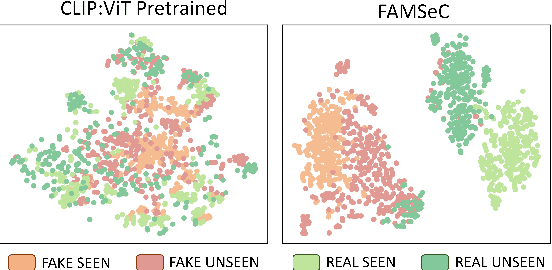

Abstract:The explosive growth of generative AI has saturated the internet with AI-generated images, raising security concerns and increasing the need for reliable detection methods. The primary requirement for such detection is generalizability, typically achieved by training on numerous fake images from various models. However, practical limitations, such as closed-source models and restricted access, often result in limited training samples. Therefore, training a general detector with few-shot samples is essential for modern detection mechanisms. To address this challenge, we propose FAMSeC, a general AI-generated image detection method based on LoRA-based Forgery Awareness Module and Semantic feature-guided Contrastive learning strategy. To effectively learn from limited samples and prevent overfitting, we developed a Forgery Awareness Module (FAM) based on LoRA, maintaining the generalization of pre-trained features. Additionally, to cooperate with FAM, we designed a Semantic feature-guided Contrastive learning strategy (SeC), making the FAM focus more on the differences between real/fake image than on the features of the samples themselves. Experiments show that FAMSeC outperforms state-of-the-art method, enhancing classification accuracy by 14.55% with just 0.56% of the training samples.
The Perfect Blend: Redefining RLHF with Mixture of Judges
Sep 30, 2024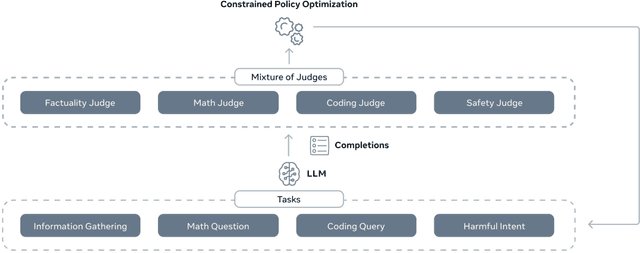
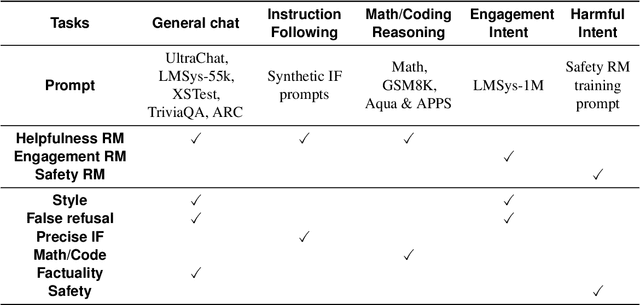
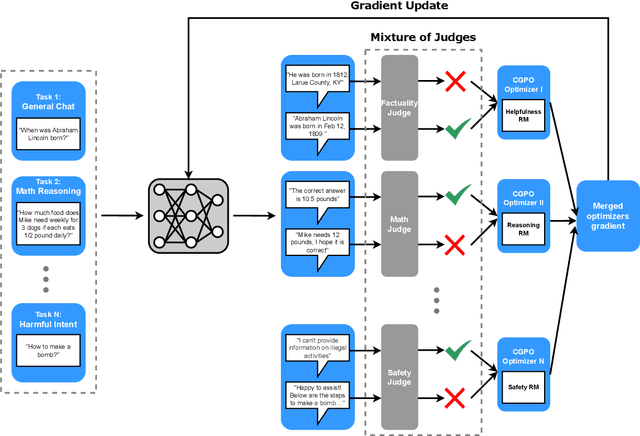
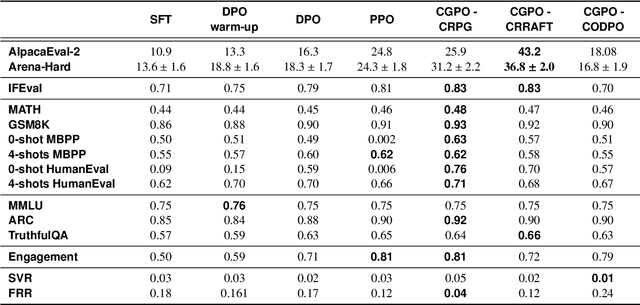
Abstract:Reinforcement learning from human feedback (RLHF) has become the leading approach for fine-tuning large language models (LLM). However, RLHF has limitations in multi-task learning (MTL) due to challenges of reward hacking and extreme multi-objective optimization (i.e., trade-off of multiple and/or sometimes conflicting objectives). Applying RLHF for MTL currently requires careful tuning of the weights for reward model and data combinations. This is often done via human intuition and does not generalize. In this work, we introduce a novel post-training paradigm which we called Constrained Generative Policy Optimization (CGPO). The core of CGPO is Mixture of Judges (MoJ) with cost-efficient constrained policy optimization with stratification, which can identify the perfect blend in RLHF in a principled manner. It shows strong empirical results with theoretical guarantees, does not require extensive hyper-parameter tuning, and is plug-and-play in common post-training pipelines. Together, this can detect and mitigate reward hacking behaviors while reaching a pareto-optimal point across an extremely large number of objectives. Our empirical evaluations demonstrate that CGPO significantly outperforms standard RLHF algorithms like PPO and DPO across various tasks including general chat, STEM questions, instruction following, and coding. Specifically, CGPO shows improvements of 7.4% in AlpacaEval-2 (general chat), 12.5% in Arena-Hard (STEM & reasoning), and consistent gains in other domains like math and coding. Notably, PPO, while commonly used, is prone to severe reward hacking in popular coding benchmarks, which CGPO successfully addresses. This breakthrough in RLHF not only tackles reward hacking and extreme multi-objective optimization challenges but also advances the state-of-the-art in aligning general-purpose LLMs for diverse applications.
Trusted Unified Feature-Neighborhood Dynamics for Multi-View Classification
Sep 01, 2024Abstract:Multi-view classification (MVC) faces inherent challenges due to domain gaps and inconsistencies across different views, often resulting in uncertainties during the fusion process. While Evidential Deep Learning (EDL) has been effective in addressing view uncertainty, existing methods predominantly rely on the Dempster-Shafer combination rule, which is sensitive to conflicting evidence and often neglects the critical role of neighborhood structures within multi-view data. To address these limitations, we propose a Trusted Unified Feature-NEighborhood Dynamics (TUNED) model for robust MVC. This method effectively integrates local and global feature-neighborhood (F-N) structures for robust decision-making. Specifically, we begin by extracting local F-N structures within each view. To further mitigate potential uncertainties and conflicts in multi-view fusion, we employ a selective Markov random field that adaptively manages cross-view neighborhood dependencies. Additionally, we employ a shared parameterized evidence extractor that learns global consensus conditioned on local F-N structures, thereby enhancing the global integration of multi-view features. Experiments on benchmark datasets show that our method improves accuracy and robustness over existing approaches, particularly in scenarios with high uncertainty and conflicting views. The code will be made available at https://github.com/JethroJames/TUNED.
 Add to Chrome
Add to Chrome Add to Firefox
Add to Firefox Add to Edge
Add to Edge